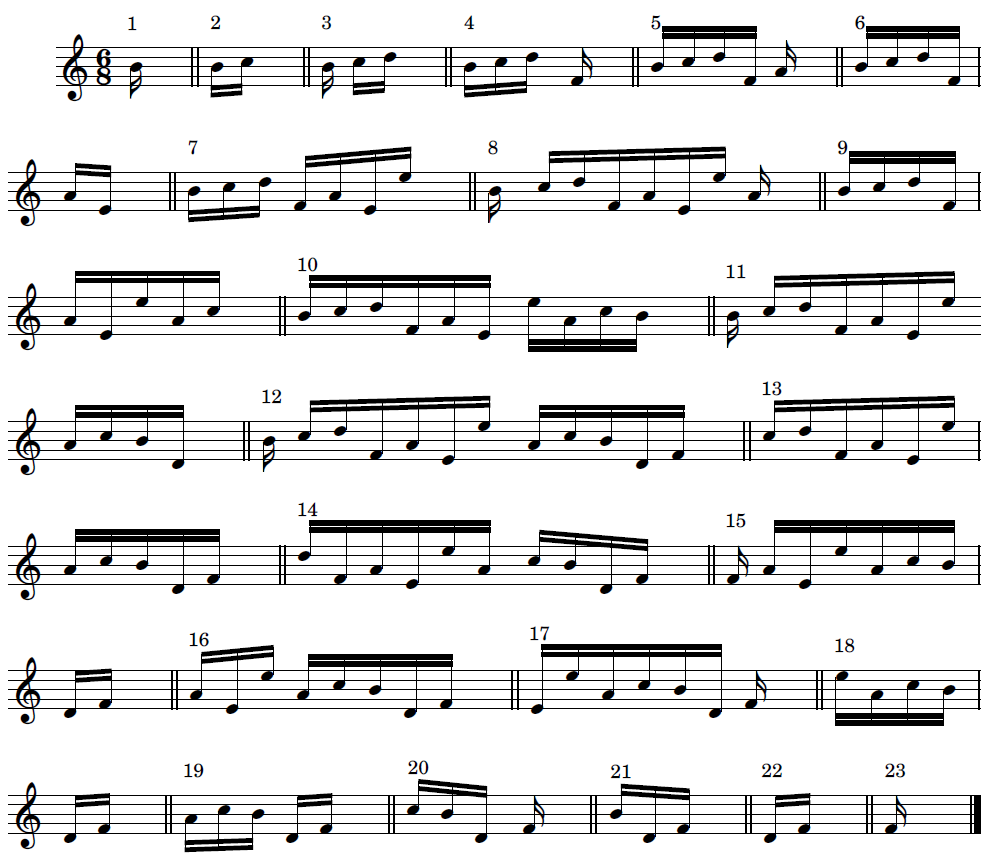Minimal Lunar Eclipse
This is a minimalist composition inspired by Steve Reich’s “Piano Phase” (1967).
It can be performed by two musicians playing the same instrument or two different instruments. The score is simply a bar in 6/8 with 12 sixteenth notes; the tempo should be between 60 and 75 beats per minute.

The measure is repeated continuously at the fixed tempo, but in chunks of increasing length. Initially, only the first note is repeated, then the first two notes, then the first three, and so on. During the performance, the lengths of the chunks played by the two players become different and this can generate interesting and mesmerizing polyrhythms.
The first player can decide when to extend its chunk by one note, then he must wait for the second player to also extend his chunk. The second player should extend his chunk preferably (but not necessarily) when it is not in sync (out of phase) with the first player, in this way, when the two players are playing the same chunk, the notes are often “shifted”. When the full bar is played a few times, the process is reversed and the chunks are shortened by cutting the first note. In this second part, the second player decides when to shorten his chunk, then he must wait the first player. The piece ends when they finally repeats the last note of the measure in sync for a few bars. The overall performance should last approximately 5-6 minutes (the duration should also depend on the satisfaction shown by the audience).
Performance guidelines
- Both players start playing and repeat the first note B4 (i.e. a “chunk of length 1”) in sync for a few 6/8 measures.
- Then Player1 can decide when to extend his chunk to the first two notes (B4, C5).
- Player1 must repeat his chunk until Player2 also decides to extend his chunk.
- Player2 doesn’t have to wait to be in phase with Player1 before extending his chunk.
- Player1 can then extend his chunk again to the first three notes (B4, C5, D5) and wait.
- The process is repeated until both players are playing the whole measure (12 sixteenth notes) at the same tempo, but not necessarily in phase. The full measure should be played at least 2-4 times.
- The process is then reversed: Player2 decides when to shorten his chunk by cutting the first note (the first note cutted will be the first note B4 of the measure).
- Player2 must continue until Player1 decides to also shorten his chunk; and so on.
- At the end the two players will be playing the last note of the measure (F4) in sync; they should play it for a few 16/8 measures, then end the piece.
- Both players should “listen” to the effect that the current chunks are producing, especially when they are of the same length, and if it sounds good they should repeat them and add dynamic variations more times before extending/shrinking.
- The tempo should be constant, but each player can decide to play some notes/parts with (limited) anticipation or retard.
- The dynamic and accents are completely arbitrary … if it sounds good it is good.
- If you want you can slowly fade-in (increase the volume) at the beginning, and slowly fade-out (decrease the volume) at the end.
- The players can use some gestures to make the performance easier: a gesture for “it’s your turn”, a gesture for “end the piece in 4-3-2-1”, a gesture for “stay on this pattern”, and so on.
- A different atmosphere can be achieved transposing the measure diatonically one or two (diatonic) steps below or above.
- Finally …. feel free to break the rules BE CREATIVE and HAVE FUN!
The two instruments should be placed far enough apart, so the audience can perceive the sounds coming from the left and right; if they are electrified/amplified the same effect can be achieved using the mixer controls. The piece can also be performed by one player using two synthesizers (or a multi-timbral synthesizer) and a sequencer capable of running patterns with different lengths. Depending on the register of the instrument used, the melody can be played in other octaves or keys; the two instruments can also play different octaves.
You can freely use this composition, but you should mention/cite the author (me). I would be very honored if you perform this piece privately or at any public event (let me know by sending an email to marziodebiasi [at] gmail [dot] com and if you have a recording or video I’ll be glad to publish/link it on my blog or YouTube channel).
You can find an example of a performance on my YouTube channel “Algoritmarte”:
You can download these guidelines in PDF format: click here.
These are the 23 “chunks”:
